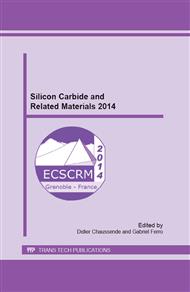p.588
p.592
p.596
p.600
p.604
p.608
p.612
p.616
p.620
Comparison of the Planar-JBS against the Trench-MOS Rectifier-Design Based on 4H-SiC for 3.3 kV Applications
Abstract:
We compare the static electronic performance of the state-of-the-art Junction-Barrier-Schottky (JBS) rectifier (manufactured by ion-implantation) against the Trench-MOS Barrier Schottky (TMBS) rectifier (manufactured by trench-etching and subsequent oxidation). In our 2D numerical simulations, we have chosen identical specifications for the epitaxial drift-layer (3.3 kV application voltage, e.g. traction) and back-side device-design, while investigating the impact of the top-cell active area design on both rectifier IV-characteristics. To enable a meaningful comparison, we designed the depth d of the shields for the electric field E equally deep (p+ peak-plateau dJBS equals trench-depth dt), such that the peak E-field (close to avalanche breakdown) inside the drift-layer of the device is located at a comparable depth near the anode-side of the rectifier (see Fig. 2). By studying systematically the ratio between shield-to Schottky contact-length (w/s ratio), we found that the unipolar conduction state of the TMBS design is basically unaffected by enlarging the Schottky-contact length s, which is enterly different for the JBS-case.
Info:
Periodical:
Pages:
604-607
Citation:
Online since:
June 2015
Authors:
Price:
Сopyright:
© 2015 Trans Tech Publications Ltd. All Rights Reserved
Share:
Citation:


